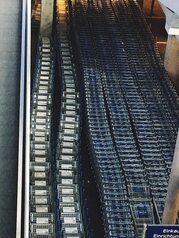The Value of Transportation: Key to Successful Investments

Transport is a fundamental pillar that determines the value of real estate investments. In a country like Costa Rica, where location and accessibility are paramount, understanding how transport influences appreciation can make the difference between a successful investment and a missed opportunity. This article will guide you through the key aspects that make transport a decisive factor when choosing the best areas to invest in real estate. Discover how to enhance your decisions and maximize your return!
The Relationship Between Transport and Surplus Value: Why Does It Matter?
The relationship between transportation and added value is fundamental to understanding the value of real estate investments. In simple terms, the accessibility provided by an efficient transportation system can significantly increase the appeal of a property. Areas well connected through roads, train lines, or public transport tend to experience higher demand, resulting in an increase in property prices. This dynamic not only benefits current owners but also attracts new investors interested in capitalizing on the potential for appreciation.
Additionally, urban planning and transportation development directly influence the quality of life of residents. Areas with good mobility options tend to be more desirable for families and workers, as they reduce the time and cost associated with daily commuting. This implies that areas with access to robust infrastructure not only see an increase in their property value but also become attractive hubs for new commercial and residential projects. Thus, understanding this relationship allows investors to make more informed decisions when selecting strategic locations where the growth of real estate value is almost assured.
2. The Best Areas in Costa Rica with Access to Public Transportation
The areas of Costa Rica with access to public transportation stand out not only for their connectivity but also for the quality of life they offer to their residents. Neighborhoods like San José, Heredia, and Alajuela are clear examples where the bus and train system facilitates daily commuting to workplaces, educational institutions, and commercial centers. This accessibility not only attracts tenants seeking convenience but also increases real estate demand, which inevitably drives property prices up in these areas.
Additionally, areas like Escazú and Curridabat have been favored by the development of modern infrastructure that complements the existing public transportation. The combination of efficient routes and an urban environment designed to facilitate mobility creates an irresistible appeal for both investors and future homeowners. A well-connected location not only ensures greater appreciation over time but also contributes to a more enjoyable daily experience for those who decide to settle there. Therefore, when evaluating investment opportunities, considering the best areas with access to public transportation becomes a decisive factor in securing a profitable and sustainable investment.
3. Road Infrastructure: Impact on Property Value
Road infrastructure is one of the most critical components in the valuation of real estate properties. A well-developed road network not only facilitates access to homes but also connects communities with essential services such as schools, hospitals, and shopping centers. This translates into higher demand from buyers and renters, who value the convenience and time savings that come from living near major routes. Therefore, properties located in areas with good road infrastructure tend to experience a significant increase in their value over time.
Additionally, future planning and expansion of roads can significantly influence property value. Projects such as new highways or public transportation systems can quickly transform an area previously considered peripheral into a highly sought-after one. Investors should pay attention to government plans and private projects that could enhance connectivity, as this not only impacts the present but also the potential future return on investment. In summary, understanding how road infrastructure affects the real estate market is essential for those looking to make informed and profitable investments.
4. Future Trends in Transportation and Their Effect on Investments
As we move towards a more connected and sustainable future, transportation trends are evolving significantly, and this has a direct impact on the value of real estate investments. The implementation of efficient public transportation systems, such as light rail or electric buses, not only improves urban mobility but also increases demand for properties near these infrastructures. Areas that offer easy access to these services tend to experience an increase in their value, becoming focal points for investors looking to maximize their long-term returns. Furthermore, the growing concern for the environment is driving a transition towards sustainable transportation modes, which can drastically alter the dynamics of the real estate market.
On the other hand, digitalization and technological advancement are reshaping the way we move. The arrival of shared mobility applications and innovative solutions like autonomous cars promises to transform the traditional concept of ownership and use of urban space. This change could lead to a decrease in the need for parking spaces and open opportunities to develop additional residential or commercial areas where there were previously spaces dedicated exclusively to automobiles. Investing in areas that quickly adapt to these new trends could be advantageous for those investors willing to anticipate changes in urban preferences and market demands. Thus, staying informed about these emerging trends will be key to making sound decisions in the real estate sector.
5. Comparative Analysis: Areas with Good Transportation vs. Isolated Areas
The comparative analysis between areas with good transportation and isolated areas reveals significant differences in property valuation. In areas where access to public transportation services is efficient, such as trains, buses, or main roads, residents enjoy greater convenience, which translates into constant real estate demand. These areas tend to experience sustained growth in their prices, as they facilitate daily commuting to work, educational, and commercial centers. Furthermore, connectivity improves the quality of life, making it attractive to potential renters and buyers.
On the other hand, isolated areas face significant challenges in terms of valuation. The lack of adequate transportation can limit interest in these areas, as residents must contend with long distances and prolonged travel times to access basic services. This not only affects the quality of life of the inhabitants but also reduces the appeal for investors. Properties in locations with poor connectivity tend to have lower value and slower growth compared to those strategically located near key transportation routes. Thus, when considering a real estate investment, it is crucial to evaluate these factors to ensure a favorable and sustainable return.
6. Transportation Projects in Development and Investment Opportunities
Development transportation projects are essential for increasing property value and improving connectivity between regions. In Costa Rica, various initiatives are underway to modernize and expand road and public transportation infrastructure, representing a significant opportunity for investors. Projects such as new roads, improvements to the train system, and bus route expansions will not only facilitate the movement of people but also enhance the appeal of previously less accessible areas. By identifying these opportunities, investors can strategically position themselves before prices adjust to the new market reality.
Additionally, it is important to consider how these developments impact urban and regional growth. The creation of free trade zones or logistics centers in areas close to new transportation hubs can stimulate the local economy and attract both businesses and residents. Investing in properties near these emerging infrastructures ensures a stronger return due to the expected increase in residential and commercial demand. Therefore, keeping an updated focus on ongoing transportation projects allows for informed decision-making and maximizes the value of the real estate portfolio in a competitive environment.
7. Success Stories: Investors Who Took Advantage of Efficient Transportation
One of the most notable cases in Costa Rica is that of a group of investors who bet on an emerging area near the new public transportation system. By analyzing the projection of urban development and the improvement in connectivity, these individuals decided to acquire land before prices adjusted to the projected growth. Thanks to their foresight and the increasing demand for accessible areas, they saw a significant rise in the value of their properties in a short time. This type of decision demonstrates how a strategic approach to transportation can transform a modest initial investment into a substantial source of profitability.
Another notable example involves developers who took advantage of improvements in road infrastructure to build residential complexes. By identifying that new roads and expansions were scheduled to connect rural areas with urban centers, these investors not only managed to capture market interest but also generated prosperous communities where there was previously little economic activity. The combination of efficient transport access and an adequate residential supply boosted both occupancy and the overall value of the project, once again demonstrating how a proper assessment of transport can be decisive for achieving success in real estate investments.
8. Practical Tips for Assessing Transportation Potential in Your Investment
To assess the transportation potential in your investment, it is essential to start by analyzing the existing infrastructure. Look at the main access routes, such as roads, highways, and public transport routes. A well-connected location not only facilitates the daily commute of residents but also increases its appeal to future tenants or buyers. Research the urban development projections in the area; if improvements in public transport or new road connections are planned, this may indicate an increase in value in the short and medium term.
Also, consider the travel time to key points such as shopping centers, schools, and work areas. Conduct tests at different times to understand how traffic affects the area's accessibility. Do not underestimate the importance of alternative transportation: bike lanes and pedestrian paths can be decisive for those seeking a more sustainable lifestyle. By evaluating all these factors, you will be able to make more informed decisions that will contribute to the success of your real estate investment.



